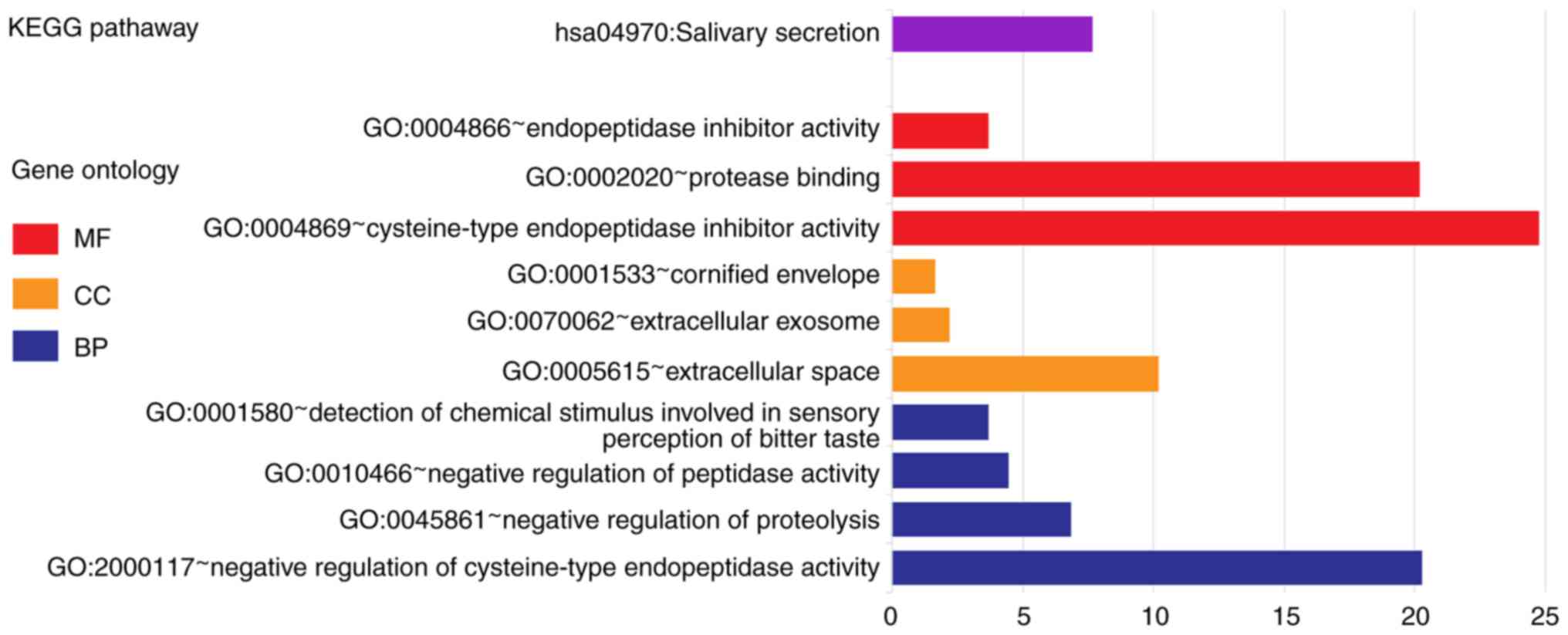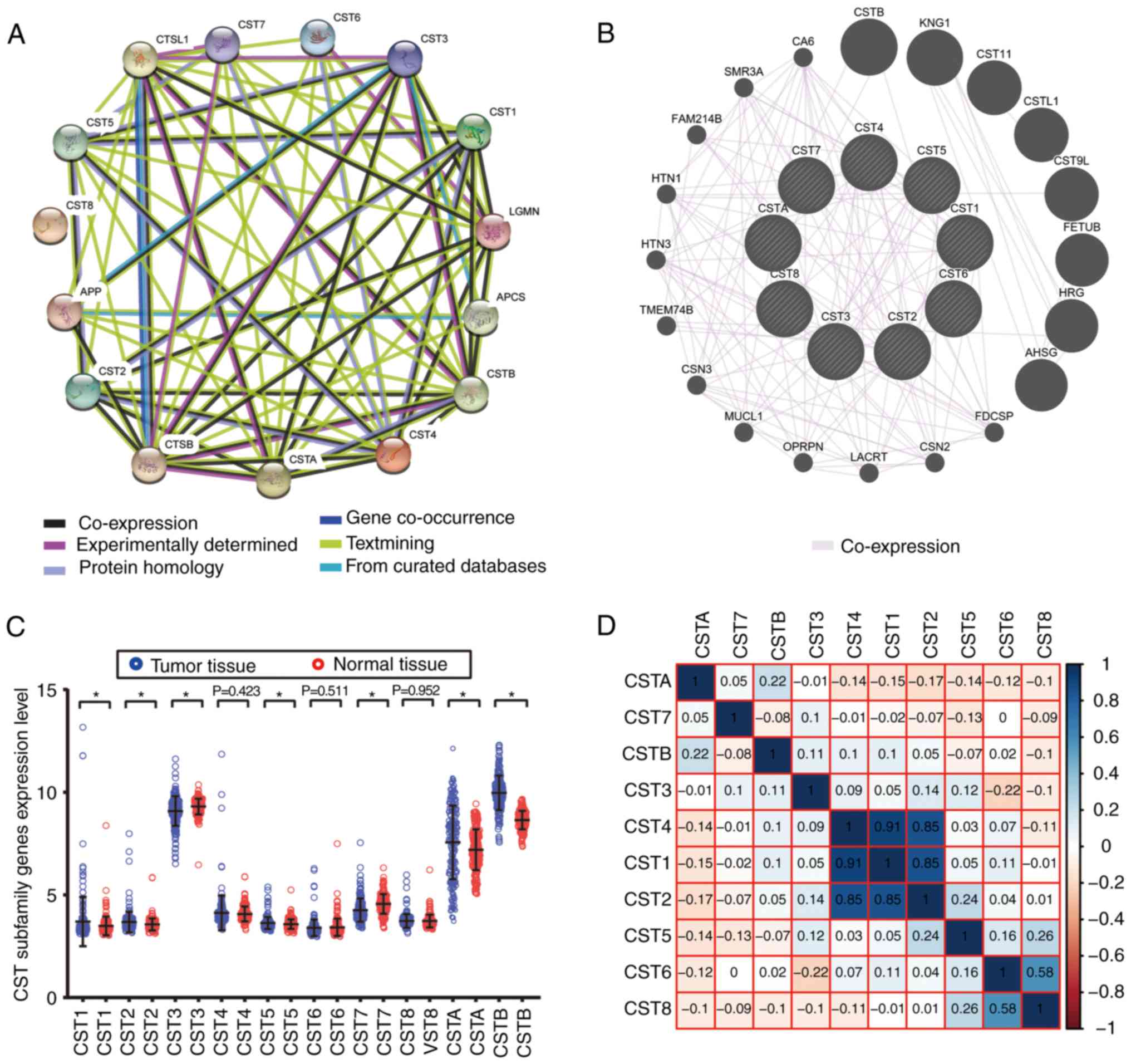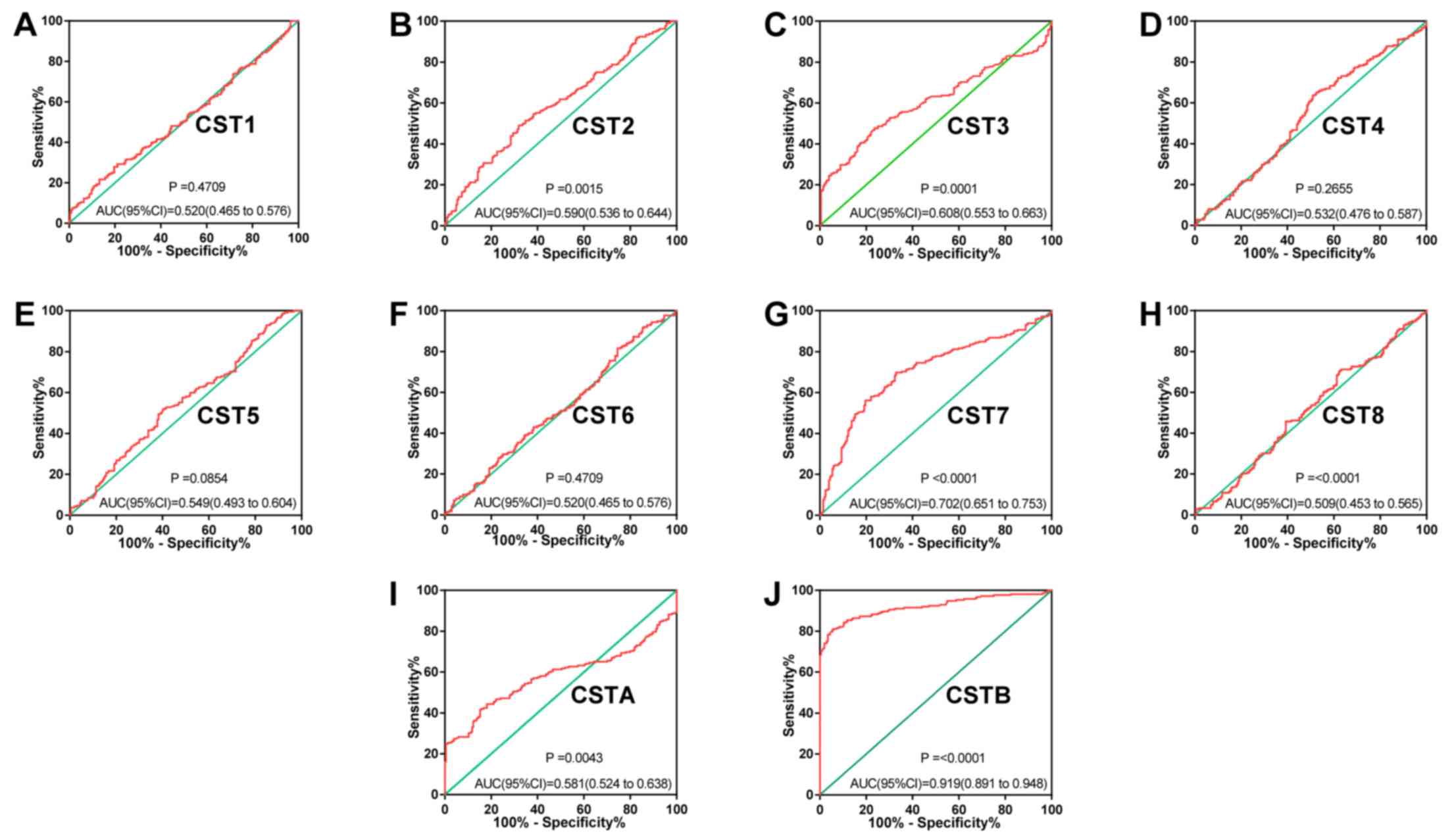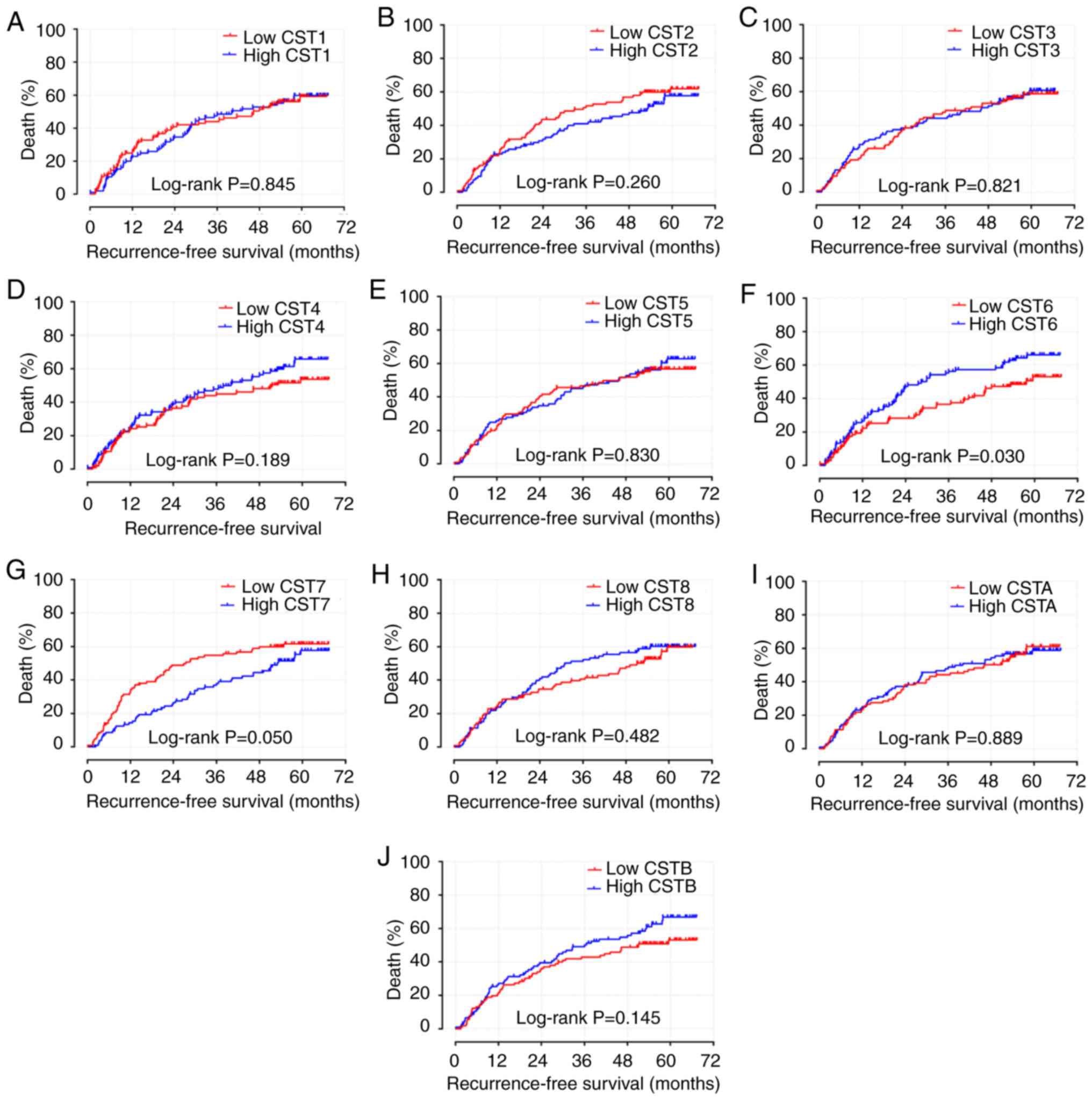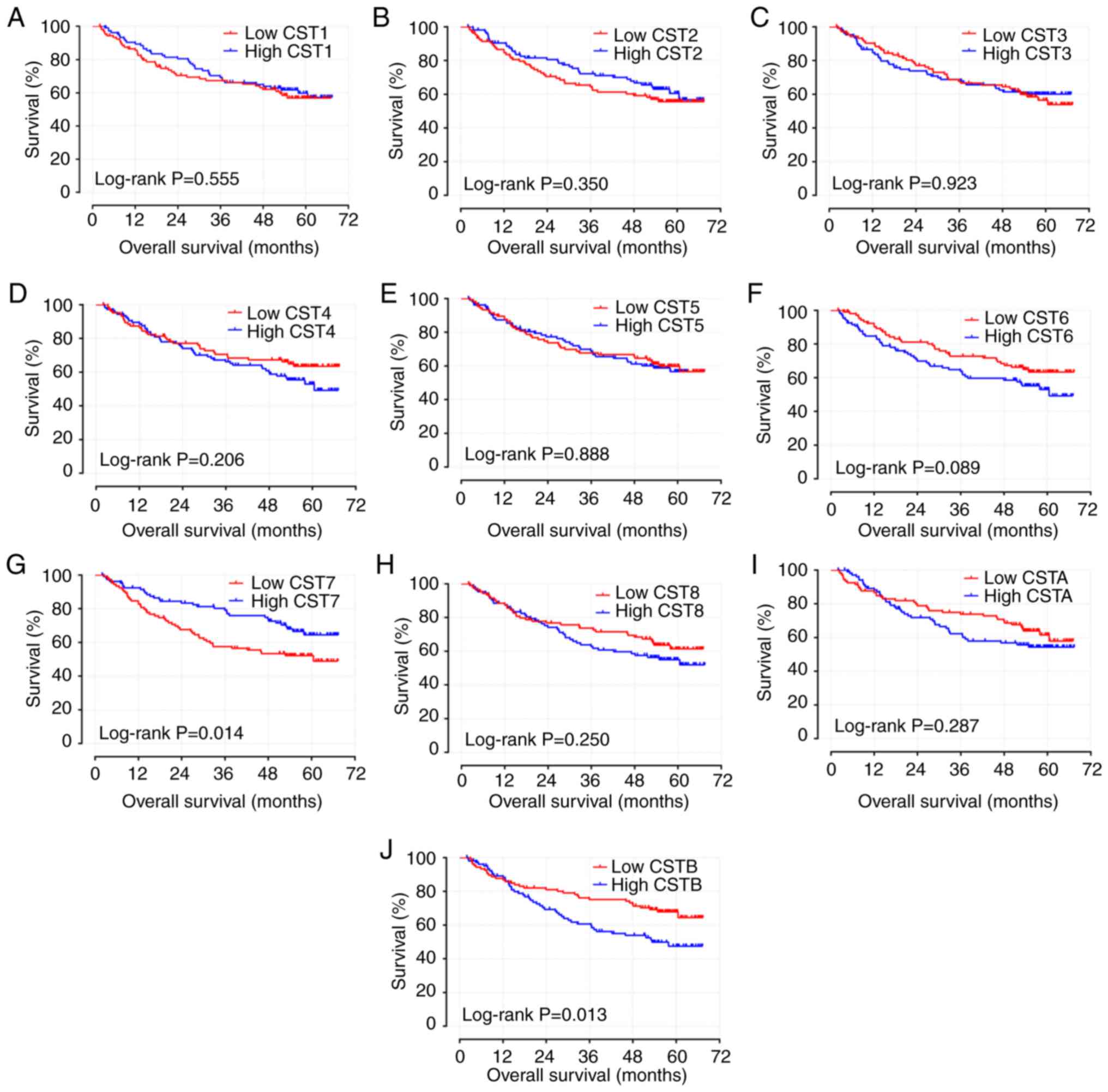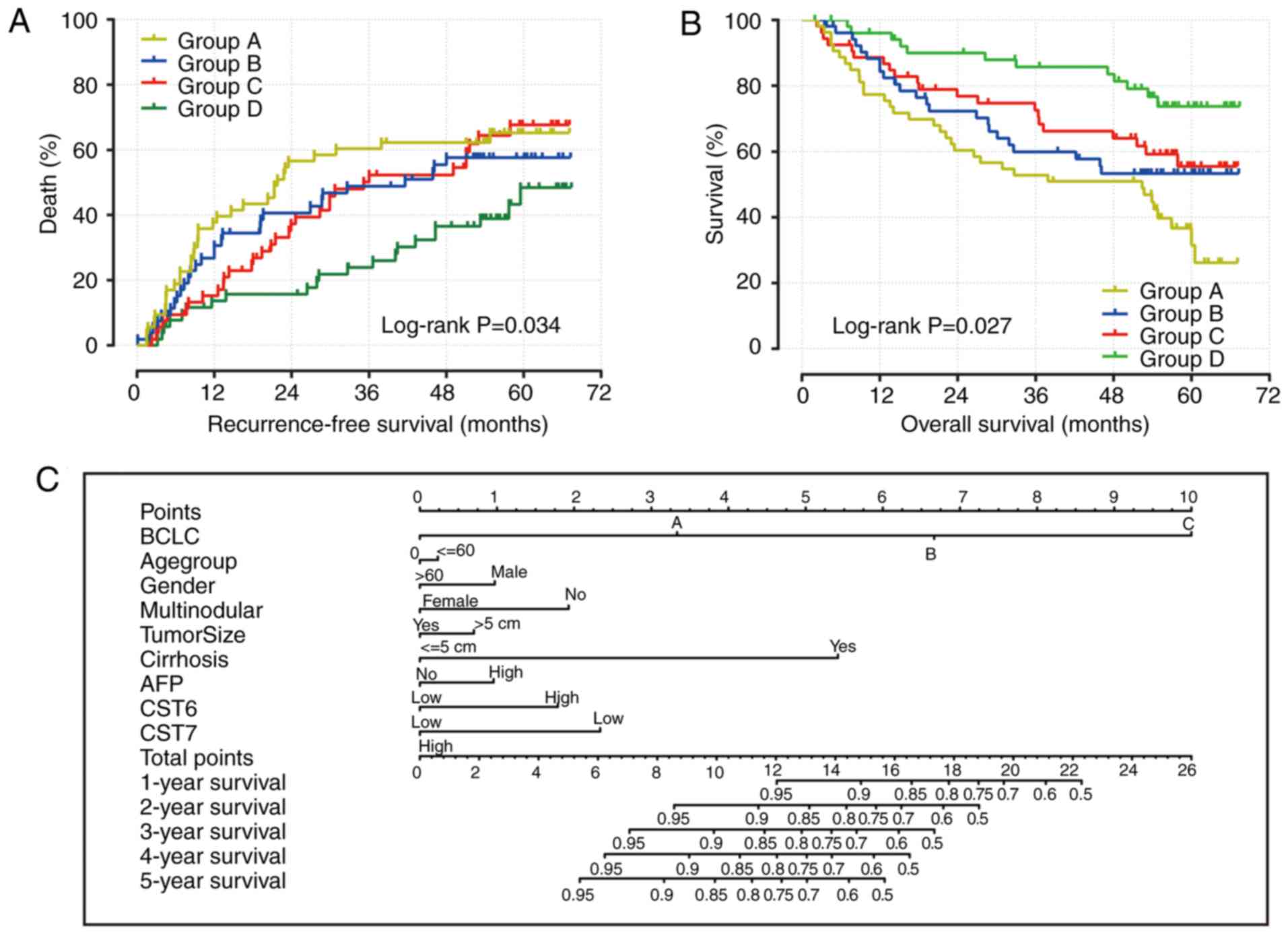|
1
|
Bray F, Ferlay J, Soerjomataram I, Siegel
RL, Torre LA and Jemal A: Global cancer statistics 2018: GLOBOCAN
estimates of incidence and mortality worldwide for 36 cancers in
185 countries. CA Cancer J Clin. 68:394–424. 2018. View Article : Google Scholar : PubMed/NCBI
|
|
2
|
Chen W, Zheng R, Baade PD, Zhang S, Zeng
H, Bray F, Jemal A, Yu XQ and He J: Cancer statistics in China,
2015. CA Cancer J Clin. 66:115–132. 2016. View Article : Google Scholar : PubMed/NCBI
|
|
3
|
Njei B, Rotman Y, Ditah I and Lim JK:
Emerging trends in hepatocellular carcinoma incidence and
mortality. Hepatology. 61:191–199. 2015. View Article : Google Scholar : PubMed/NCBI
|
|
4
|
Zeng H, Zheng R, Guo Y, Zhang S, Zou X,
Wang N, Zhang L, Tang J, Chen J, Wei K, et al: Cancer survival in
China, 2003-2005: A population-based study. Int J Cancer.
136:1921–1930. 2015. View Article : Google Scholar : PubMed/NCBI
|
|
5
|
Altekruse SF, McGlynn KA and Reichman ME:
Hepatocellular carcinoma incidence, mortality, and survival trends
in the United States from 1975 to 2005. J Clin Oncol. 27:1485–1491.
2009. View Article : Google Scholar : PubMed/NCBI
|
|
6
|
Torre LA, Bray F, Siegel RL, Ferlay J,
Lortet-Tieulent J and Jemal A: Global cancer statistics, 2012. CA
Cancer J Clin. 65:87–108. 2015. View Article : Google Scholar : PubMed/NCBI
|
|
7
|
Volk ML and Marrero JA: Early detection of
liver cancer: Diagnosis and management. Curr Gastroenterol Rep.
10:60–66. 2008. View Article : Google Scholar : PubMed/NCBI
|
|
8
|
Sawyers CL: The cancer biomarker problem.
Nature. 452:548–552. 2008. View Article : Google Scholar : PubMed/NCBI
|
|
9
|
Gora J and Latajka R: Involvement of
cysteine proteases in cancer. Curr Med Chem. 22:944–957. 2015.
View Article : Google Scholar : PubMed/NCBI
|
|
10
|
Ochieng J and Chaudhuri G: Cystatin
superfamily. J Health Care Poor Underserved. 21 (Suppl 1):S51–S70.
2010. View Article : Google Scholar
|
|
11
|
Turk V, Stoka V and Turk D: Cystatins:
Biochemical and structural properties, and medical relevance. Front
Biosci. 13:5406–5420. 2008. View
Article : Google Scholar : PubMed/NCBI
|
|
12
|
Sinha AA, Gleason DF, Deleon OF, Wilson MJ
and Sloane BF: Localization of a biotinylated cathepsin B
oligonucleotide probe in human prostate including invasive cells
and invasive edges by in situ hybridization. Anat Rec. 235:233–240.
1993. View Article : Google Scholar : PubMed/NCBI
|
|
13
|
Visscher DW, Sloane BF, Sameni M, Babiarz
JW, Jacobson J and Crissman JD: Clinicopathologic significance of
cathepsin B immunostaining in transitional neoplasia. Mod Pathol.
7:76–81. 1994.PubMed/NCBI
|
|
14
|
Lin YY, Chen ZW, Lin ZP, Lin LB, Yang XM,
Xu LY and Xie Q: Tissue levels of stefin A and stefin B in
hepatocellular carcinoma. Anat Rec (Hoboken). 299:428–438. 2016.
View Article : Google Scholar : PubMed/NCBI
|
|
15
|
Zinkin NT, Grall F, Bhaskar K, Otu HH,
Spentzos D, Kalmowitz B, Wells M, Guerrero M, Asara JM, Libermann
TA and Afdhal NH: Serum proteomics and biomarkers in hepatocellular
carcinoma and chronic liver disease. Clin Cancer Res. 14:470–477.
2008. View Article : Google Scholar : PubMed/NCBI
|
|
16
|
Lee MJ, Yu GR, Park SH, Cho BH, Ahn JS,
Park HJ, Song EY and Kim DG: Identification of cystatin B as a
potential serum marker in hepatocellular carcinoma. Clin Cancer
Res. 14:1080–1089. 2008. View Article : Google Scholar : PubMed/NCBI
|
|
17
|
Dennis G Jr, Sherman BT, Hosack DA, Yang
J, Gao W, Lane HC and Lempicki RA: DAVID: Database for annotation,
visualization, and integrated discovery. Genome Biol. 4:P32003.
View Article : Google Scholar : PubMed/NCBI
|
|
18
|
Huang DW, Sherman BT, Tan Q, Kir J, Liu D,
Bryant D, Guo Y, Stephens R, Baseler MW, Lane HC and Lempicki RA:
DAVID bioinformatics resources: Expanded annotation database and
novel algorithms to better extract biology from large gene lists.
Nucleic Acids Res 35 (Web Server issue). W169–W175. 2007.
View Article : Google Scholar
|
|
19
|
Warde-Farley D, Donaldson SL, Comes O,
Zuberi K, Badrawi R, Chao P, Franz M, Grouios C, Kazi F, Lopes CT,
et al: The GeneMANIA prediction server: Biological network
integration for gene prioritization and predicting gene function.
Nucleic Acids Res 38 (Web Server issue). W214–W220. 2010.
View Article : Google Scholar
|
|
20
|
Montojo J, Zuberi K, Rodriguez H, Bader GD
and Morris Q: GeneMANIA: Fast gene network construction and
function prediction for Cytoscape. F1000Res. 3:1532014. View Article : Google Scholar : PubMed/NCBI
|
|
21
|
von Mering C, Huynen M, Jaeggi D, Schmidt
S, Bork P and Snel B: STRING: A database of predicted functional
associations between proteins. Nucleic Acids Res. 31:258–261. 2003.
View Article : Google Scholar : PubMed/NCBI
|
|
22
|
Szklarczyk D, Morris JH, Cook H, Kuhn M,
Wyder S, Simonovic M, Santos A, Doncheva NT, Roth A, Bork P, et al:
The STRING database in 2017: Quality-controlled protein-protein
association networks, made broadly accessible. Nucleic Acids Res.
45:D362–D368. 2017. View Article : Google Scholar : PubMed/NCBI
|
|
23
|
Cancer Genome Atlas Research Network.
Electronic address, . simplewheeler@bcm.edu; Cancer
Genome AtlasResearch Network: Comprehensive and integrative genomic
characterization of hepatocellular carcinoma. Cell.
169:1327–1341.e23. 2017. View Article : Google Scholar : PubMed/NCBI
|
|
24
|
Liao X, Liu X, Yang C, Wang X, Yu T, Han
C, Huang K, Zhu G, Su H, Qin W, et al: Distinct diagnostic and
prognostic values of minichromosome maintenance gene expression in
patients with hepatocellular carcinoma. J Cancer. 9:2357–2373.
2018. View Article : Google Scholar : PubMed/NCBI
|
|
25
|
Roessler S, Long EL, Budhu A, Chen Y, Zhao
X, Ji J, Walker R, Jia HL, Ye QH, Qin LX, et al: Integrative
genomic identification of genes on 8p associated with
hepatocellular carcinoma progression and patient survival.
Gastroenterology. 142:957–966e12. 2012. View Article : Google Scholar : PubMed/NCBI
|
|
26
|
Hoo ZH, Candlish J and Teare D: What is an
ROC curve? Emerg Med J. 34:357–359. 2017. View Article : Google Scholar : PubMed/NCBI
|
|
27
|
Ma H, Bandos AI, Rockette HE and Gur D: On
use of partial area under the ROC curve for evaluation of
diagnostic performance. Stat Med. 32:3449–3458. 2013. View Article : Google Scholar : PubMed/NCBI
|
|
28
|
Balachandran VP, Gonen M, Smith JJ and
DeMatteo RP: Nomograms in oncology: More than meets the eye. Lancet
Oncol. 16:e173–e180. 2015. View Article : Google Scholar : PubMed/NCBI
|
|
29
|
Subramanian A, Tamayo P, Mootha VK,
Mukherjee S, Ebert BL, Gillette MA, Paulovich A, Pomeroy SL, Golub
TR, Lander ES and Mesirov JP: Gene set enrichment analysis: A
knowledge-based approach for interpreting genome-wide expression
profiles. Proc Natl Acad Sci USA. 102:15545–15550. 2005. View Article : Google Scholar : PubMed/NCBI
|
|
30
|
Liberzon A, Birger C, Thorvaldsdóttir H,
Ghandi M, Mesirov JP and Tamayo P: The molecular signatures
database (MSigDB) hallmark gene set collection. Cell Syst.
1:417–425. 2015. View Article : Google Scholar : PubMed/NCBI
|
|
31
|
François O, Martins H, Caye K and
Schoville SD: Controlling false discoveries in genome scans for
selection. Mol Ecol. 25:454–469. 2016. View Article : Google Scholar : PubMed/NCBI
|
|
32
|
Glickman ME, Rao SR and Schultz MR: False
discovery rate control is a recommended alternative to
Bonferroni-type adjustments in health studies. J Clin Epidemiol.
67:850–857. 2014. View Article : Google Scholar : PubMed/NCBI
|
|
33
|
Reiner A, Yekutieli D and Benjamini Y:
Identifying differentially expressed genes using false discovery
rate controlling procedures. Bioinformatics. 19:368–375. 2003.
View Article : Google Scholar : PubMed/NCBI
|
|
34
|
Llovet JM, Brú C and Bruix J: Prognosis of
hepatocellular carcinoma: The BCLC staging classification. Semin
Liver Dis. 19:329–338. 1999. View Article : Google Scholar : PubMed/NCBI
|
|
35
|
Liotta LA, Rao CN and Barsky SH: Tumor
invasion and the extracellular matrix. Lab Invest. 49:636–649.
1983.PubMed/NCBI
|
|
36
|
Cudic M and Fields GB: Extracellular
proteases as targets for drug development. Curr Protein Pept Sci.
10:297–307. 2009. View Article : Google Scholar : PubMed/NCBI
|
|
37
|
Yan S, Sameni M and Sloane BF: Cathepsin B
and human tumor progression. Biol Chem. 379:113–123.
1998.PubMed/NCBI
|
|
38
|
Mirković B, Markelc B, Butinar M, Mitrović
A, Sosič I, Gobec S, Vasiljeva O, Turk B, Čemažar M, Serša G and
Kos J: Nitroxoline impairs tumor progression in vitro and in vivo
by regulating cathepsin B activity. Oncotarget. 6:19027–19042.
2015. View Article : Google Scholar : PubMed/NCBI
|
|
39
|
Aggarwal N and Sloane BF: Cathepsin B:
Multiple roles in cancer. Proteomics Clin Appl. 8:427–437. 2014.
View Article : Google Scholar : PubMed/NCBI
|
|
40
|
Feldman AS, Banyard J, Wu CL, McDougal WS
and Zetter BR: Cystatin B as a tissue and urinary biomarker of
bladder cancer recurrence and disease progression. Clin Cancer Res.
15:1024–1031. 2009. View Article : Google Scholar : PubMed/NCBI
|
|
41
|
Leto G, Incorvaia L, Flandina C, Ancona C,
Fulfaro F, Crescimanno M, Sepporta MV and Badalamenti G: Clinical
impact of cystatin C/cathepsin L and follistatin/activin A systems
in breast cancer progression: A preliminary report. Cancer Invest.
34:415–423. 2016. View Article : Google Scholar : PubMed/NCBI
|
|
42
|
Ai L, Kim WJ, Kim TY, Fields CR, Massoll
NA, Robertson KD and Brown KD: Epigenetic silencing of the tumor
suppressor cystatin M occurs during breast cancer progression.
Cancer Res. 66:7899–7909. 2006. View Article : Google Scholar : PubMed/NCBI
|
|
43
|
Shiba D, Terayama M, Yamada K, Hagiwara T,
Oyama C, Tamura-Nakano M, Igari T, Yokoi C, Soma D, Nohara K, et
al: Clinicopathological significance of cystatin A expression in
progression of esophageal squamous cell carcinoma. Medicine
(Baltimore). 97:e03572018. View Article : Google Scholar : PubMed/NCBI
|
|
44
|
Wang X, Gui L, Zhang Y, Zhang J, Shi J and
Xu G: Cystatin B is a progression marker of human epithelial
ovarian tumors mediated by the TGF-β signaling pathway. Int J
Oncol. 44:1099–1106. 2014. View Article : Google Scholar : PubMed/NCBI
|
|
45
|
Pulukuri SM, Gorantla B, Knost JA and Rao
JS: Frequent loss of cystatin E/M expression implicated in the
progression of prostate cancer. Oncogene. 28:2829–2838. 2009.
View Article : Google Scholar : PubMed/NCBI
|
|
46
|
Unić A, Derek L, Duvnjak M, Patrlj L,
Rakić M, Kujundžić M, Renjić V, Štoković N, Dinjar P, Jukic A and
Grgurević I: Diagnostic specificity and sensitivity of PIVKAII,
GP3, CSTB, SCCA1 and HGF for the diagnosis of hepatocellular
carcinoma in patients with alcoholic liver cirrhosis. Ann Clin
Biochem. 55:355–362. 2018. View Article : Google Scholar : PubMed/NCBI
|
|
47
|
Takaya A, Peng WX, Ishino K, Kudo M,
Yamamoto T, Wada R, Takeshita T and Naito Z: Cystatin B as a
potential diagnostic biomarker in ovarian clear cell carcinoma. Int
J Oncol. 46:1573–1581. 2015. View Article : Google Scholar : PubMed/NCBI
|
|
48
|
Li Q, Zheng ZC, Ni CJ, Jin WX, Jin YX,
Chen Y, Zhang XH, Chen ED and Cai YF: Correlation of cystatin E/M
with clinicopathological features and prognosis in triple-negative
breast cancer. Ann Clin Lab Sci. 48:40–44. 2018.PubMed/NCBI
|
|
49
|
Soh H, Venkatesan N, Veena MS,
Ravichandran S, Zinabadi A, Basak SK, Parvatiyar K, Srivastava M,
Liang LJ, Gjertson DW, et al: Cystatin E/M suppresses tumor cell
growth through cytoplasmic retention of NF-κB. Mol Cell Biol.
36:1776–1792. 2016. View Article : Google Scholar : PubMed/NCBI
|
|
50
|
Shridhar R, Zhang J, Song J, Booth BA,
Kevil CG, Sotiropoulou G, Sloane BF and Keppler D: Cystatin M
suppresses the malignant phenotype of human MDA-MB-435S cells.
Oncogene. 23:2206–2215. 2004. View Article : Google Scholar : PubMed/NCBI
|
|
51
|
Kioulafa M, Balkouranidou I, Sotiropoulou
G, Kaklamanis L, Mavroudis D, Georgoulias V and Lianidou ES:
Methylation of cystatin M promoter is associated with unfavorable
prognosis in operable breast cancer. Int J Cancer. 125:2887–2892.
2009. View Article : Google Scholar : PubMed/NCBI
|
|
52
|
Chen X, Cao X, Dong W, Xia M, Luo S, Fan Q
and Xie J: Cystatin M expression is reduced in gastric carcinoma
and is associated with promoter hypermethylation. Biochem Biophys
Res Commun. 391:1070–1074. 2010. View Article : Google Scholar : PubMed/NCBI
|
|
53
|
Qiu J, Ai L, Ramachandran C, Yao B,
Gopalakrishnan S, Fields CR, Delmas AL, Dyer LM, Melnick SJ,
Yachnis AT, et al: Invasion suppressor cystatin E/M (CST6):
High-level cell type-specific expression in normal brain and
epigenetic silencing in gliomas. Lab Invest. 88:910–925. 2008.
View Article : Google Scholar : PubMed/NCBI
|
|
54
|
Veena MS, Lee G, Keppler D, Mendonca MS,
Redpath JL, Stanbridge EJ, Wilczynski SP and Srivatsan ES:
Inactivation of the cystatin E/M tumor suppressor gene in cervical
cancer. Genes Chromosomes Cancer. 47:740–754. 2008. View Article : Google Scholar : PubMed/NCBI
|
|
55
|
McCarthy DJ, Chen Y and Smyth GK:
Differential expression analysis of multifactor RNA-Seq experiments
with respect to biological variation. Nucleic Acids Res.
40:4288–4297. 2012. View Article : Google Scholar : PubMed/NCBI
|
|
56
|
Ji NY, Kang YH, Park MY, Lee CI, Kim MK,
Kim DG, Kim JW and Song EY: Development of a fluorescent
microsphere immunoassay for cystatin B (CSTB) in serum of patients
with hepatocellular carcinoma. Clin Chem Lab Med. 49:151–155. 2011.
View Article : Google Scholar : PubMed/NCBI
|
|
57
|
Ma Y, Chen Y and Petersen I: Expression
and epigenetic regulation of cystatin B in lung cancer and
colorectal cancer. Pathol Res Pract. 213:1568–1574. 2017.
View Article : Google Scholar : PubMed/NCBI
|
|
58
|
Zhang J, Shi Z, Huang J and Zou X: CSTB
downregulation promotes cell proliferation and migration and
suppresses apoptosis in gastric cancer SGC-7901 cell line. Oncol
Res. 24:487–494. 2016. View Article : Google Scholar : PubMed/NCBI
|
|
59
|
Coulibaly S, Schwihla H, Abrahamson M,
Albini A, Cerni C, Clark JL, Ng KM, Katunuma N, Schlappack O,
Glössl J and Mach L: Modulation of invasive properties of murine
squamous carcinoma cells by heterologous expression of cathepsin B
and cystatin C. Int J Cancer. 83:526–531. 1999. View Article : Google Scholar : PubMed/NCBI
|
|
60
|
Tamai Y, Iwasa M, Kawasaki Y, Yoshizawa N,
Ogura S, Sugimoto R, Eguchi A, Yamamoto N, Sugimoto K, Hasegawa H
and Takei Y: Ratio between estimated glomerular filtration rates of
creatinine and cystatin C predicts overall survival in patients
with hepatocellular carcinoma. Hepatol Res. 49:153–163. 2019.
View Article : Google Scholar : PubMed/NCBI
|















